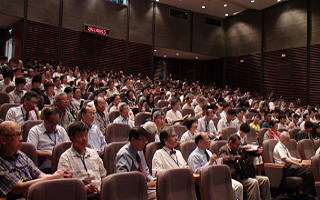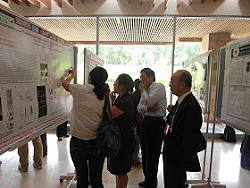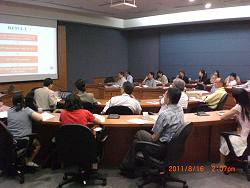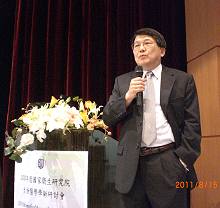NHRI Communications

會議報導
100年度國家衛生研究院生物醫學學術研討會紀實
NHRI reports on 2011 Biomedical Research Symposium
 100年度國家衛生研究院生物醫學學術研討會(2011 Biomedical Research Symposium of NHRI)於8月15日至16日假本院會議中心舉行。此次會議除有整合性計畫研究人員參與外,亦邀請院外計畫學術審查之國內、外專家60餘位共同與會,另開放本院及國內各機構研究人員報名與會,總計約550餘人參加,可謂盛況空前,充分達到學術交流之目的。
100年度國家衛生研究院生物醫學學術研討會(2011 Biomedical Research Symposium of NHRI)於8月15日至16日假本院會議中心舉行。此次會議除有整合性計畫研究人員參與外,亦邀請院外計畫學術審查之國內、外專家60餘位共同與會,另開放本院及國內各機構研究人員報名與會,總計約550餘人參加,可謂盛況空前,充分達到學術交流之目的。自2008年起,本院於每年8月暑假期間,藉由辦理涵蓋各領域的國際學術研討會方式與國、內外學者進行交流,除了展現本院當年度所支持的院內、外研究成果,更冀望成為國內、外生醫學界朋友在暑期積極參與的學術盛事。
會議首日上午,本院伍焜玉院長主持開幕後,由美國紐澤西醫學及牙科大學羅伯伍德強生醫學院藥理學系劉昉院士以「From DNA Topology to Cancer Therapy and Beyond」為題發表演說註1;次日上午則由國立交通大學吳妍華院士以「Biological Roles of DDX3 RNA Helicase in Development and Disease」為題發表演說註2。
除前述特別演講外,另規劃「Biomedical Science」、「Population Health Research」、「Molecular Genetics and Medicine」、「Neural Science」、「Cancer Research」及「Medical Engineering」等6項專題演講,由執行成果優良之整合性醫藥衛生科技研究計畫主持人、本院研究人員及國內、外專家共26位,於2個會場同步進行演講,分享其研究成果與經驗,促進學術交流及研究合作。
 囿於演講場次有限,本次會議另安排2個壁報時段,由整合性計畫主持人及本院研究人員張貼壁報展示研究成果(共計發表129篇壁報論文),並於第2天下午分組安排壁報論文討論會議,由各組會議主持人邀請部分壁報展示之研究人員簡短報告分享研究成果,以促進壁報發表者、計畫主持人、所有分組與會人員及學術審查委員間之討論與互動,除有助於委員瞭解計畫執行成效,亦能協助解決研究過程可能遭遇之困難。
囿於演講場次有限,本次會議另安排2個壁報時段,由整合性計畫主持人及本院研究人員張貼壁報展示研究成果(共計發表129篇壁報論文),並於第2天下午分組安排壁報論文討論會議,由各組會議主持人邀請部分壁報展示之研究人員簡短報告分享研究成果,以促進壁報發表者、計畫主持人、所有分組與會人員及學術審查委員間之討論與互動,除有助於委員瞭解計畫執行成效,亦能協助解決研究過程可能遭遇之困難。 在2天的學術活動中,藉由演講、壁報論文展示及分組討論會議等安排,引發熱烈討論及腦力激盪,使與會人員獲益良多,且因交流互動增加,而致未來合作或團隊研究形成之可能,為國人之醫藥研究發展水準厚植潛力。
在2天的學術活動中,藉由演講、壁報論文展示及分組討論會議等安排,引發熱烈討論及腦力激盪,使與會人員獲益良多,且因交流互動增加,而致未來合作或團隊研究形成之可能,為國人之醫藥研究發展水準厚植潛力。註1:劉昉院士特別演講摘要(影音節目)

From DNA Topology to Cancer Therapy and Beyond
 This presentation will be an overview of four decades of research on DNA topoisomerases and their applications in cancer therapy. The presentation will consist of four parts: (1) A historical overview of the discovery of DNA topoisomerases, starting from the discovery of the first DNA topoisomerase (ω protein) by Dr. James C. Wang. (2) Discussion on the strand-passing mechanism of DNA topoisomerases, focusing on human type II DNA topoisomerases and their covalent reaction intermediates. (3) Discussion on topoisomerase II-targeting cancer therapeutics, and the role of the two isozymes, TopIIα and TopIIβ. Specifically, the role of TopIIβ in etoposide-induced secondary malignancy (i.e. therapy-related acute myeloid leukemia or t-AML) and doxorubicin cardiotoxicity will be discussed, together with ways to improve antitumor efficacy by preferential targeting the human TopIIα isozyme. (4) Discussion on the general mechanism for processing-repair of topoisomerase-DNA covalent complexes, with emphasis on a novel transcription elongation-dependent and ubiquitin-independent proteasome pathway for processing TopII cleavage complexes into DNA double-strand breaks.
This presentation will be an overview of four decades of research on DNA topoisomerases and their applications in cancer therapy. The presentation will consist of four parts: (1) A historical overview of the discovery of DNA topoisomerases, starting from the discovery of the first DNA topoisomerase (ω protein) by Dr. James C. Wang. (2) Discussion on the strand-passing mechanism of DNA topoisomerases, focusing on human type II DNA topoisomerases and their covalent reaction intermediates. (3) Discussion on topoisomerase II-targeting cancer therapeutics, and the role of the two isozymes, TopIIα and TopIIβ. Specifically, the role of TopIIβ in etoposide-induced secondary malignancy (i.e. therapy-related acute myeloid leukemia or t-AML) and doxorubicin cardiotoxicity will be discussed, together with ways to improve antitumor efficacy by preferential targeting the human TopIIα isozyme. (4) Discussion on the general mechanism for processing-repair of topoisomerase-DNA covalent complexes, with emphasis on a novel transcription elongation-dependent and ubiquitin-independent proteasome pathway for processing TopII cleavage complexes into DNA double-strand breaks.註2:吳妍華院士特別演講摘要(影音節目)

Biological Roles of DDX3 RNA Helicase in Development and Disease
 DDX3 is a ubiquitously expressed DEAD box RNA helicase. Over the past few years, an array of divergent cellular functions for DDX3 has been reported. Currently, DDX3 has been the subject of intensive investigation because of its therapeutic potential in viral pathogenesis and tumorigenesis.
DDX3 is a ubiquitously expressed DEAD box RNA helicase. Over the past few years, an array of divergent cellular functions for DDX3 has been reported. Currently, DDX3 has been the subject of intensive investigation because of its therapeutic potential in viral pathogenesis and tumorigenesis.DDX3 has been shown to be required for the replication of HCV and HIV. Most remarkably, DDX3 was recently demonstrated to be a prime target for viral evasion strategies due to its contribution to IFNβ production and its involvement in innate immune signaling pathways. At least four viruses, HCV, HBV, HIV and poxviruses, all encode DDX3-targeting viral proteins to modulate its function and make DDX3 a novel target for drug development.
DDX3 has been reported to exert positive or negative effects on cell growth control and tumorigenesis. DDX3 expression is down-regulated in hepatocellular carcinoma (HCC) samples, in particular those from HBV-positive and male patients. The cell growth-suppressive property of DDX3 is linked to its cooperation with Sp1 to up-regulate the p21waf1/cip1 promoter. More recently, reduced p21waf1/cip1 via alteration of p53-DDX3 pathway is reported to be associated with poor relapse-free survival in early-stage human papillomavirus-associated lung cancer. Furthermore, an alteration of subcellular localization from nuclei to cytoplasm was also observed in cutaneous squamous carcinoma. In addition, DDX3 could also function as an eIF4E inhibitory protein to specifically repress cap-dependent translation. All these features together suggest a tumor suppressor role of DDX3. However, it was postulated that DDX3 has an oncogenic role in breast carcinogenesis. DDX3 may aid cancer progression by repressing E-cadherin expression and promoting Snail expression. Moreover, DDX3 is also reported to be critical for cyclin E1 mRNA translation and cell growth control, which could be linked to its oncogenic roles.
To gain insight into the developmental roles of DDX3, we inactivate the Ddx3x locus in conventional, epiblast- and neural crest cell-specific knockout mice. The analysis of the offspring genotype implied that Ddx3x is crucial for embryogenesis and organs development. The underlying molecular mechanisms are now under investigation.
In conclusion, due to the multi-functionality of DDX3, its functional roles in diseases and development may depend on the cell type, its associated viral or cellular factors, its cellular localization, the targeted function of DDX3, the post-translational modification and the environmental conditions. Understanding the enormously complicated network of these factors in molecular detail can provide valuable insights to develop effective means to target DDX3 for treat or control of viral infection and carcinoma.
《文/圖:學術發展處蕭振祥》